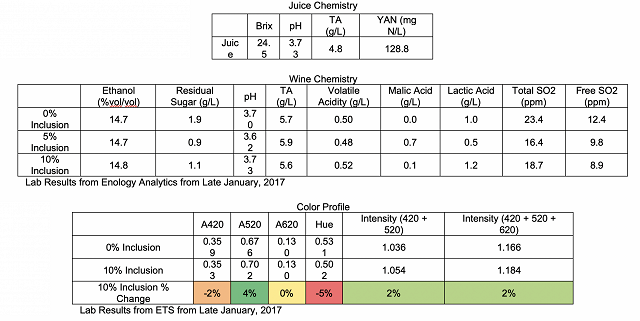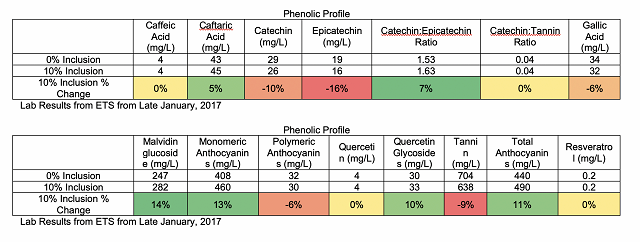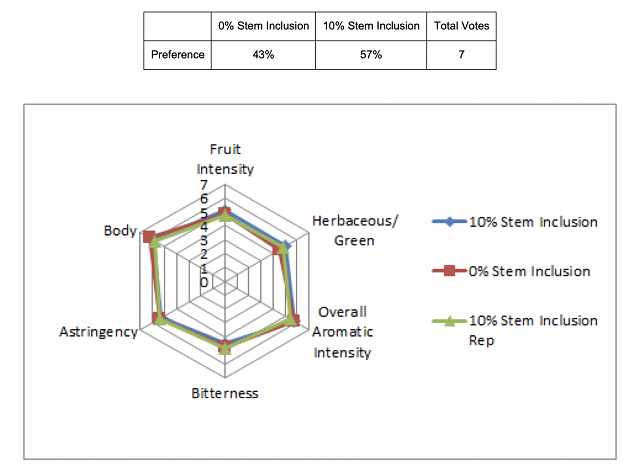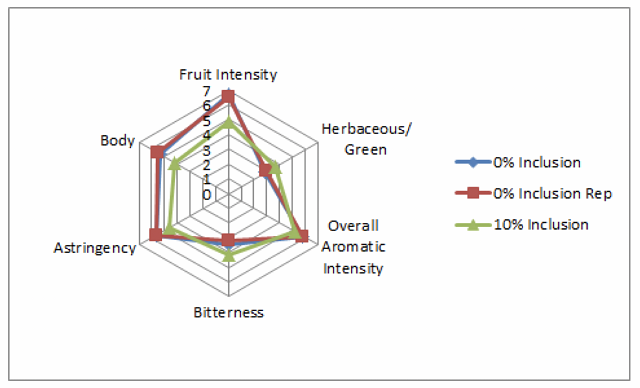Stem Inclusion in Cabernet Franc Fermentations (2016)
Stephen Barnard
Keswick Vineyards
Summary
Cabernet Franc Grapes were hand harvested and then destemmed into three lots. The first lot contained no stems, the second lot had 5% stems included based on fruit weight, and the third lot had 10% stems included based on fruit weight (ie: 1 pound of stems for every 10 pounds of fruit in the 10% inclusion treatment). All other treatments between lots were the same. Phenolic and color profiles were not gathered for the 5% treatment. Additionally, because the 5% inclusion did not complete malolactic conversion, it was excluded from tastings. 10% stem inclusion did not result in many chemical differences between wines. Monomeric anthocyanins, quercetin, malvidin glucoside, and total anthocyanins were increased by stem inclusion, whereas tannin was decreased. This increase in anthocyanin, however, did not greatly alter color intensity, possibly due in part to the decrease in polymeric pigment. Overall, these wines were not found to be significantly different from each other. There were slight trends for the stem inclusion to increase Bitterness and Herbaceous/Green character, and reduce Body. This study should be repeated over several vintages, as well as with different grape varieties in order to better determine the full impact of stem inclusion with Virginia ripening conditions. Additionally, this would be an interesting project to see how the wine evolves over time, to see if differences grow over time.
Introduction
The role of whole cluster and stem inclusion in winemaking is very controversial. Whole cluster fermentation is often used in Burgundian Pinot noir and is thought to add complexity to the wine (Weston 2000). Whole clusters are thought to round out and complement the low tannin in Pinot noir, and the flavors of Syrah can be complemented by stems (Meisner 2016). However, whole cluster inclusion also results in stems being added to the wine. Stems can enhance structure and wine quality sometimes, but also can add vegetal aromas (Ribèreau-Gayon et al. 2006). In certain cases, these vegetal aromas can also be perceived as spicy, and may act as a counterbalance to overly fruity qualities. Vegetal aromas and tannin additions may also balance out some carbonic maceration character which is found in whole cluster inclusion, which enhances ester aromatics, extends fermentation after pressing, and reduces the contribution of seed tannin. Stem inclusion is less common for Bordeaux varieties because of their already high levels of pyrazine (Meisner 2016). The reticence to use stems due to pyrazine characteristics in certain varieties is likely unfounded, due to cultural practices and climatic conditions which can greatly lower pyrazine character. Stems tend to lower alcohol content, decrease titratable acidity, and increase pH (due to high potassium levels). Stems can contribute a large amount of tannin to wine. Additionally, stems tend to decrease color intensity by adsorbing anthocyanins (Ribèreau-Gayon et al. 2006; Reshef et al. 2016). Finally, wines made with stem inclusion tend to have higher color stability over time (Ribèreau-Gayon et al. 2006). These results vary, however (Ribèreau-Gayon et al. 2006), and are dependent on many other factors, such as extraction kinetics, maceration practices, the level of crushing in the grapes, grape variety, and possibly stem maturity. Whole cluster and stem inclusion require much more thorough study before any hard conclusions can be drawn. This study examines the impact of stem inclusion on Cabernet Franc wine.
Results and Discussion
Stem inclusion did not result in many chemical differences between wines. Monomeric anthocyanins, quercetin, malvidin glucoside, and total anthocyanins were increased by stem inclusion, whereas tannin was decreased. This increase in anthocyanin, however, did not greatly alter color intensity, possibly due in part to the decrease in polymeric pigment.


For the triangle test on April 26, of 21 people who answered, 7 people chose the correct wine (33%), suggesting that the wines were not significantly different. Of those who correctly identified the different wine, there did not appear to be much preference for one over the other. No strong trends were found with the descriptors used in this study. The 0% stem inclusion treatment seemed to have slightly lower Herbaceous/Green qualities, and perhaps more Body. It should be noted that the wines had undergone a malolactic fermentation in bottle, and although the carbonation and aroma seems to have “blown off” by the time the wines were tasted, this may have still interfered with the sensory analysis. Newer samples (without the malolactic character) were used for the remaining sensory sessions.

For the triangle test on May 3, of 10 people who voted, 4 chose the correct wine (40%), suggesting that the wines were not significantly different. Of those 4, 3 of them preferred the wine made from stem inclusion, and one had no preference. For the descriptive analysis at the May 3 tasting, no strong trends could be seen but there was a fairly good tendency for the stem inclusion wine to have higher Overall Aromatic Intensity. The stem inclusion wine also had slight tendencies toward higher Fruit Intensity and Bitterness.

For the triangle test on May 17, of 8 people who answered, 4 people chose the correct wine (50%), suggesting that the wines were not significantly different. These wines were voted to have an average degree difference of 5.3 (out of 10), suggesting that the wines were moderately different (but only three answered this). 3 out of 4 judges who answered correctly preferred the wine with 0% inclusion. No strong trends can be seen for the descriptors used in this study at the May 17 tasting. There was a slight trend for the 10% inclusion wine to have lower Fruit Intensity, Body, and Astringency and higher Bitterness and Herbaceous/Green Character.

Overall, these wines were not found to be significantly different from each other. There were slight trends for the stem inclusion to increase Bitterness and Herbaceous/Green character, and reduce Body. This study would be very interesting to observe over several years to see how the wines evolve. This study should also be repeated over several vintages, with more quantification of the quality of the stems. This would greatly help determine the best practices of when to use stems for different kinds of vintages.
Methods
Cabernet Franc was hand-harvested on 9/28 and transferred to cold storage for 18 hours. The following day, the fruit was destemmed and separated into three lots. The first lot was destemmed with no stems included, the second lot had 5% stems included based on fruit weight, and the third lot had 10% stems included based on fruit weight. To each bin was added 1.2g/L tartaric acid, 500ppm FT Rouge, 30g/hL Opti Red, 20g/ton EX-V, and each were then inoculated with GRE yeast at 30g/hL. Additions were mixed in through punchdown. Fermentations lasted 12 days with three punch downs per day. At 12 Brix each bin received 30g/hL Fermaid K. Bins were pressed after the same amount of maceration time and wine was transferred directly into barrel. The barrels were identical 3 year old-Old World Cooperage. Malolactic conversion was spontaneous, and had not yet completed at the time of bottling.
This project was tasted on April 26, May 3, and May 17. For the triangle test and preference analysis, anybody who did not answer the form were removed from consideration for both triangle, degree of difference, and preference. Additionally, anybody who answered the triangle test incorrectly were removed from consideration for degree of difference and preference. Additionally, any data points for preference which did not make sense (such as a person ranking a wine and its replicate at most and least preferred, when they correctly guessed the odd wine) were removed.
In order to balance the data set to perform statistical analysis for descriptive analysis on the April 26 tasting, any judge who had not fully completed the descriptive analysis ratings were removed. In order to then make the amount of judges between groups equivalent, one judge from group 1 and group 3 were eliminated. This resulted in a final data set of 3 groups, each with 6 judges (considered as replications within groups, and groups were considered as assessors). Data was analyzed using Panel Check V1.4.2. Because this is not a truly statistical set-up, any results which are found to be statistically significant (p<0.05) will be denoted as a “strong trend” or a “strong tendency,” as opposed to general trends or tendencies. The statistical significance here will ignore any other significant effects or interactions which may confound the results (such as a statistically significant interaction of Judge x Wine confounding a significant result from Wine alone). The descriptors used in this study were Fruit Intensity, Herbaceous/Green, Overall Aromatic Intensity, Bitterness, Astringency, and Body.
The same procedures for data analysis were used on the May 3 tasting. For the descriptive analysis in this tasting, one judge was transferred from group 1 to group 3 so that each group had 3 judges, for a total of 9 judges.
The same procedures for data analysis were used on the May 17 tasting. For the descriptive analysis in this tasting, each group had two judges, for a total of 6 judges. In order to balance this data set, one judge was removed from group 1.
References
Meisner, M. 2016. Fermentation 101: The case for whole clusters. Last Bottle. http://blog.lastbottlewines.com/education/whole-clusters/. Accessed 2/10/2017.
Reshef, N., Morata, A., and Suárez-Lepe, J.A. 2016. Towards the use of grapevine by-products for reducing the alcohol content of wines. Biointerface Research in applied Chemistry. 6:1531-1537.
Ribèreau-Gayon, P., Dubourdieu, D., Donèche, B., and Lonvaud, A. 2006. Handbook of Enology, Volume 1: The Microbiology of Wine and Vinifications 2nd Edition. John Wiley & Sons. Chichester, West Sussex, England.
Weston, L.A. 2000. Grape and wine tannins and phenolics – their roles in flavor, quality and human health. 29thAnnual New York Wine Industry Workshop. https://ecommons.cornell.edu/handle/1813/39812. Accessed 2/7/2017.
